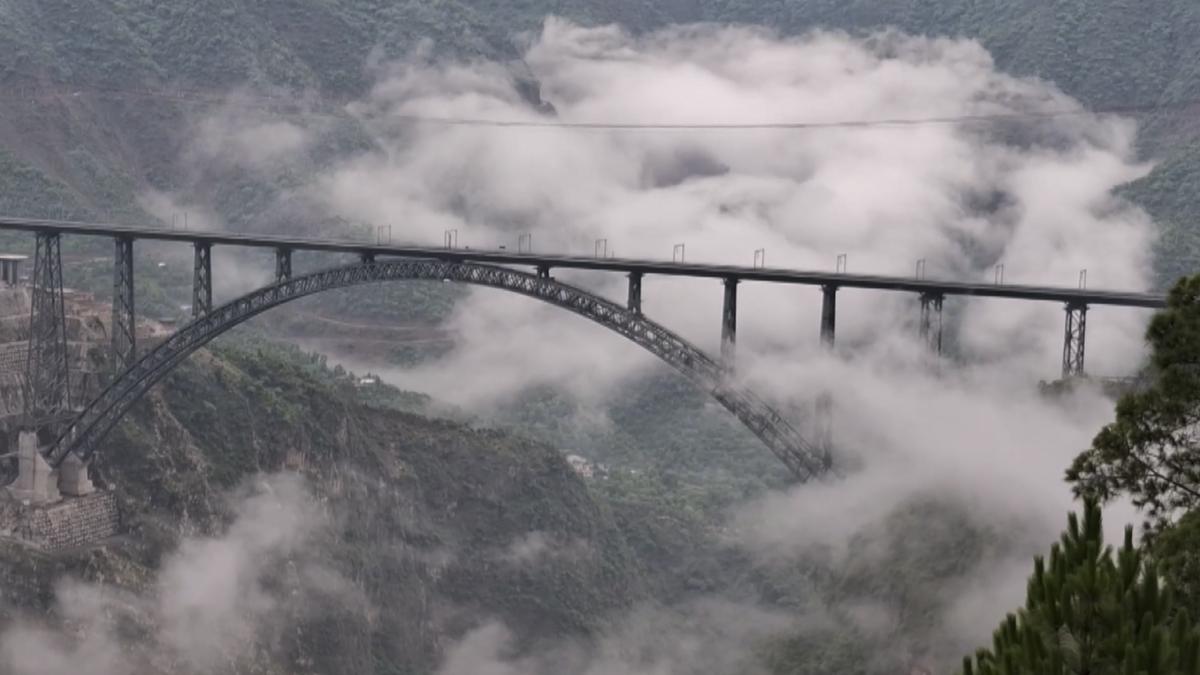
The Chenab railway bridge in Reasi district in Jammu and Kashmir.
| Photo Credit: PTI
The recent inauguration of the Chenab railway bridge by Prime Minister Narendra Modi is emblematic of India’s new politics of imagery. Hailed as the world’s highest rail arch, the bridge leaps across a chasm in Jammu and Kashmir, its elegance rendered into nationalist spectacle. The plan to display it on the Independence Day invitation card signals that infrastructural grandeur is the foremost motif of the republic — and the citizen is invited not to traverse or question but to behold and admire it.
A society wracked by inequity and developmental deficits celebrates nationhood in the form of engineered titans: the world’s tallest statue, the longest railway bridge, the widest expressway. These achievements are feted in lavish state ceremonies, nationalist rhetoric, and media blitzes designed to inspire awe. But how does grandeur rather than inclusion become the idiom of national pride?
Symbols of exclusion
India’s fondness for gigantism is not accidental. The very size of the project is its message. When the Statue of Unity rose from the banks of the Narmada, it wasn’t just a work of art or a tribute to a statesman: it was a declaration writ large in stone and steel of a Hindu-first narrative, with Sardar Vallabhbhai Patel recast as a symbol of unity against imagined internal foes. The mythos that envelopes such projects smothers questions of distributive justice. Who benefits when governments spend astronomical sums on such initiatives? Whose aspirations do they serve and silence?
Every engineering marvel draws on a carefully curated past. In India, the current government’s embrace of large-scale building projects is paralleled by its project to rewrite history. The ambition is not just to fill skylines but to repopulate the national imagination with icons drawn solely from a few mythologies.
The making of nation states often involves tearing down colonial-era symbols, recasting historical figures, and erecting new ones that embody the prevailing ideology. But what is striking about contemporary India is the scale and ferocity with which these projects have been pursued, and the drive to anchor national belonging in visual monumental forms. The Kashi Vishwanath Corridor is more than a series of temples and walkways, for example: it’s a literal and figurative reclamation, in a city perceived to be the civilisational heart of the Hindu polity. Here, engineering prowess is being marshalled to announce who belongs and who doesn’t.
Of course, nation-building has always produced spectacle. The Eiffel Tower, the Hoover Dam, and the Great Wall have all served to bind citizens to an idea greater than themselves. But in India’s nationalism, the spectacle operates with a particular logic: it’s a sign of progress but also asserts dominance. The Statue of Unity gleams while local Adivasi communities, displaced from their ancestral lands, watch with little say in the project that now overshadows them. Expressways, while useful, are undertaken with a gusto that often mocks the villages flanking them awaiting clean water and toilets. The new India is not a place where the peripheries are uplifted to the centre but where a singular vision radiates outwards, flattening multitudes in its path.
Engineering in particular lends itself seamlessly to this ideological programme because of the language of precision that engineering projects embody. Concrete, steel, and glass can be measured, weighed, and installed. Their timelines, costs, and visual impact can be displayed as evidence of political will and executive competence. In an era in which governance is increasingly judged on optics rather than outcomes, every new temple or monument becomes testament to the regime’s ‘can do’ spirit.
This is not empowerment. Even when prosperity is in the offing, the benefits of such projects rarely flow equitably. Mega-dams inundate villages; stadiums rise while informal settlements are razed; and metro lines are built with scant regard for labour conditions or environmental consequences. Government efforts to bore tunnels through the Himalayan frontier — the world’s youngest, arguably most fragile mountains — are presented as triumphs of ingenuity and grit, shrinking distances and fortifying borders. Yet the scenes of excavation mask the scarring of ecologically fragile mountainsides, the uprooting of Indigenous communities, and the haste of it all that mocks environmental and social consent. There is little room here for participatory democracy.
These impulses are most apparent in the erasure of marginal communities and alternative histories from the landscape of the new nation. Large engineering projects have become instruments of progress and of recalibration, of crafting a physical and symbolic order that must be admired and obeyed. Legal processes are twisted to fast-track construction. Public consultations are perfunctory and often organised long after decisions have been made. This is the grammar of the prevailing nationalism — a style that grants primacy to order, magnitude, and uniformity and disdains the messy business of democracy.
Serving communities
India’s earliest engineering masterworks — stepwells, ancient irrigation systems, and the Mughal gardens — served communities, not just sovereigns. Identity and inclusion need not be strangers to national achievement. Success can also be measured in the lives touched, the voices heard, and the spaces opened to everyone. Yet India’s nationalism seems to fear such a reckoning, and no wonder: no monument can command loyalty in perpetuity if those on whom it is built remain strangers to its promise.
Published – August 12, 2025 01:30 am IST
